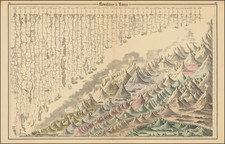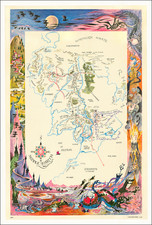"Look at the birds before you, and mark the affectionate glance of the mother, as she stands beside her beloved younglings!" - John James Audubon, Ornithological Biography, page 458
An exceptional Havell edition John James Audubon aquatinted and engraved plate depicting a male and female common cormorant with two hatchlings perched on their nest above the ocean. This hand-colored aquatint comes from the largest format of plates in the double elephant folio Birds of America.
The scene depicted on the plate took place in Labrador in 1833, high above the crashing waves of the St. Lawrence, when Audubon crawled along a cliff to get a better view of the bird's nesting and parenting habits.
This is plate CCLXVI (266) from the first double elephant folio edition of Audubon's Birds of America.
Audubon's Descriptive Text
Audubon provided an extensive description of the present image and the birds depicted within it in his Ornithological Biography, as well as this recitation of the exciting scene from which this plate was drawn:
Look at the birds before you, and mark the affectionate glance of the mother, as she stands beside her beloved younglings! I wish you could have witnessed the actions of such groups as I did while in Labrador. Methinks I still see the high rolling billows of the St Lawrence breaking in foaming masses against the huge cliffs, on the shelves of which the Cormorant places its nest. I lie flat on the edge of the precipice some hundred feet above the turbulent waters, and now crawling along with all care, I find myself only a few yards above the spot on which the parent bird and her young are fondling each other, quite unconscious of my being near. How delighted I am to witness their affectionate gratulations, hear their lisping notes, mark the tremulous motions of their expanded throats, and the curious vacillations of their heads and necks! The kind mother gently caresses each alternately with her bill; the little ones draw nearer to her, and, as if anxious to evince their gratitude, rub their heads against hers. How pleasing all this is to me! But at this moment the mother accidentally looks upward, her keen eye has met mine, she utters a croak, spreads her sable wings, and in terror launches into the air, leaving her brood at my mercy. Far and near, above and beneath me, the anxious parent passes and repasses; her flight is now unnatural, and she seems crippled, for she would fain perform those actions in the air, which other birds perform on the ground or on the water, in such distressing moments of anxiety for the fate of their beloved young. Her many neighbours, all as suspicious as herself, well understand the meaning of her mode of flight, and one after another take to wing, so that the air is in a manner blackened with them. Some fly far over the waters, others glide along the face of the bold rock, but none that have observed me realight, and how many of those there are I am pretty certain, as the greater number follow in the track of the one most concerned. Meanwhile the little ones, in their great alarm, have crawled into a recess, and there they are huddled together. I have witnessed their pleasures and terrors and now, crawling backwards, I leave them to resume their ordinary state of peaceful security.
...
Later in the common cormorant passage of the Ornithological Biography, Audubon includes extensive anatomical notes on the birds "Adult Male in March. Plate CCLX VI. Fig. 1.", "Female in July. Plate CCLXVI. Fig. 2.", and "Young Birds unfledged. Plate CCLXVI. Fig. 3, 4."
John James Audubon's Double Elephant Folio Birds of America: The Havell Edition (1827-1838)
The present hand-colored original Audubon print comes from the Havell double elephant folio edition of Birds of America, the greatest color plate book ever made. This work was Audubon's magnum opus and was published at immense expense over almost a decade, between 1827 and 1838. The Havell Edition of Birds of America included 435 hand-color aquatinted plates, and it is estimated that between 165 and 175 complete sets were produced. Today, a given individual image probably exists in no more than 60 loose examples, though for some plates the number will be much lower. Audubon aquatint engravings from the Havell Edition were printed on J. Whatman wove paper, the best paper in the world at the time - and to this day an exceptional fine art paper. The sheets of paper were approximately 26½ x 39½ inches untrimmed. Importantly, they all feature watermarks that are variations on "J.Whatman" or "J.Whatman / Turkey Mill" with the date of manufacture sometimes appended. In addition to the name of the bird depicted (and sometimes its gender, age, and botanical notes as well) Audubon's name and the name of the engraver also appear printed on Havell Edition plates. On the lower left side is printed "Drawn from nature by John James Audubon F.R.S. and F.L.S." (Fellow of the Royal Society of London and Fellow of the Linnaean Society). The only exception to this is Plate 64, Swamp Sparrow, in which Lucy Audubon is credited. On the lower right side is printed "Engraved by" (in a few cases the words "Engraved and colored by" or "Retouched by" appear) followed by the name W.H. Lizars or Robert Havell, Jr. (Sometime after his father's death in 1832 Robert Havell, Jr. dropped the Jr.)
John James Audubon (1785-1851), born Jean-Jacques Rabin in Haiti on April 26, 1785, was a Franco-American ornithologist, naturalist, and painter, celebrated for his detailed illustrations of North American birds in their natural habitats. His major work, a color-plate book titled The Birds of America, is considered one of the finest ornithological works ever produced.
Audubon's early years were shaped by tumultuous events. Born out of wedlock in the French Caribbean colony of Saint-Domingue (now Haiti) to a Creole mother and a French sea captain, he was smuggled to Nantes, France, during a slave rebellion. There, he was adopted by his father and stepmother and raised as their own. His childhood in France was filled with outdoor adventures and initial forays into drawing.
In 1803, to avoid conscription into Napoleon's army, he was sent to America, where he managed one of his father's estates near Philadelphia. This move further kindled his profound interest in the wildlife of the New World. Despite a few failed business ventures and challenges, Audubon remained committed to his passion for nature and art.
His dream to document all of the birds of America began to take form in the 1810s. Travelling through America's wilderness, Audubon observed, hunted, and painted birds. He developed a particular technique that involved wiring freshly killed birds into a natural pose on a board. This innovative method combined with his keen observation allowed him to create more lifelike illustrations than many of his contemporaries.
Failing to secure American subscribers or a publisher for his extensive collection, Audubon traveled to the United Kingdom in 1826. There, The Birds of America was met with critical acclaim. Between 1827 and 1838, this work was published in sections, comprising 435 hand-colored, life-sized prints made from engraved plates.
Audubon followed this success with a companion work, Ornithological Biography, which provided detailed narratives about each species. His later work included studies of American mammals, and he became one of the founding members of the New-York Historical Society.
Despite facing numerous challenges throughout his life, including financial hardships and criticism from some peers, Audubon's dedication to his work resulted in an invaluable contribution to ornithology and American art. He died on January 27, 1851, in New York City. Today, his legacy continues, notably through the National Audubon Society, which promotes conservation and appreciation of birds and their habitats.










![[ Bill L Stiles--9th Member of the Jesse James Gang -- 3 page letter dated August 16, 1934 ]](https://storage.googleapis.com/raremaps/img/small/38845.jpg)
![[Tampa] Perfecto Garcia & Bros. Clear Havana Cigars](https://storage.googleapis.com/raremaps/img/small/87436.jpg)

![[ Palm Readers Map ] The Art of Divining by Lines in the Hand](https://storage.googleapis.com/raremaps/img/small/78794.jpg)
![[Historical Time Line Map -- Creation To 100 AD] Tableau de L'Histoire Sainte Depuis La Creation du monde jusqu'a la dispersion du Juifs . . .](https://storage.googleapis.com/raremaps/img/small/82069.jpg)